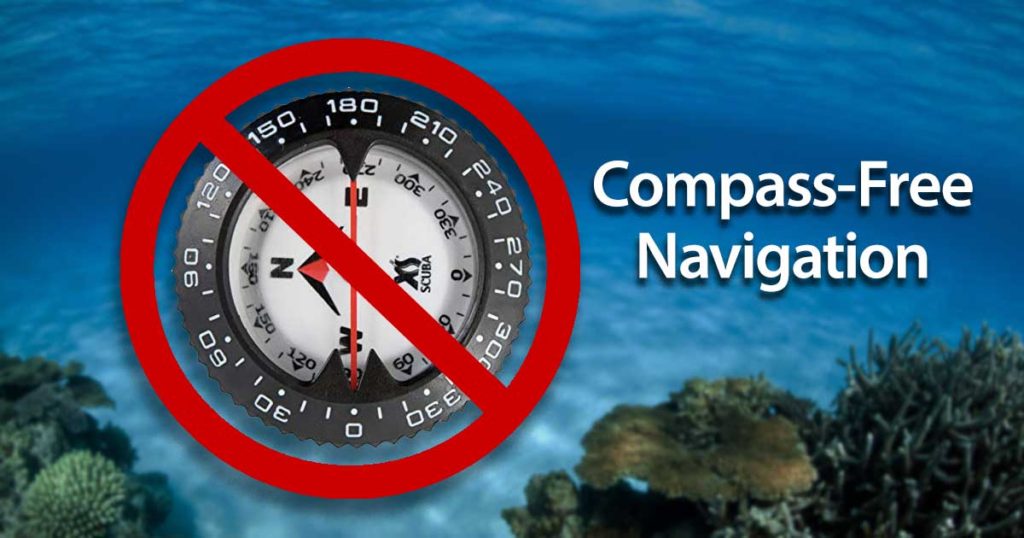There are many benefits to being able to find your way underwater. Among them:
- It can allow you to locate a new favorite dive spot or relocate an old one.
- Being able to get to your designation underwater can save you a long, tiring surface swim and, in the process, reduce the risks posed by boat traffic.
- Knowing how to find your way can help ensure you finish your dive as close as possible to the boat or exit point on shore.
Unfortunately, underwater navigation is a topic many divers don’t like to think about. Why? Because they assume it’s all about using compasses. And using compasses involves complicated terms such as azimuth, bearing, heading, reciprocal and lubber line.
The irony is, knowledgeable divers seldom, if ever, use compasses. They rely, instead, on natural navigation.
What is natural navigation?
Simply put, natural navigation is finding your way underwater using only the clues that nature — and occasionally man — provide. It’s how you would instinctively find your way if you’d never heard of compasses.
Knowing more about how to take advantage of these clues can help you find more, see more and do more underwater. In this article, we will identify some of these clues and how best to use them.
Sand ripples
Most of the time, sand ripples form parallel to shore. Therefore, if you are swimming at 90 degrees to the ripples, you are generally swimming either toward the shore or away from it.
Sand ripples are not something you would typically use as your sole means of navigation. Rather, they work in combination with other clues to confirm you are headed in the right direction.
Reef lines
This is perhaps the most common tool divers in saltwater Florida use for natural navigation. While reefs can form as isolated patches of coral, they generally form in surprisingly straight lines. Therefore, a typical reef dive may consist of little more than following the reef line away from your starting point, then following it back.
Following a reef line has an added benefit. The overhanging ledges at the edge of most reefs is generally where the greatest number of fish and other creatures hang out. This is also where you will find some of the best opportunities for photos and video.
Landmarks
A unique coral formation, some form of man-made debris or other objects can serve as landmarks to help guide you on your way. If you passed a distinct landmark on the outbound leg of your dive, you should expect to pass it again when returning to the boat or shore. Doing so helps confirm you are headed in the right direction.
Depth
In general, the farther you get from shore, the deeper the water gets. Therefore, if you are cutting across the sand ripples and the water is getting deeper, you are heading away from shore. The reverse will be true on your way back.
Walls and slopes
Walls and slopes can provide excellent navigation references. If you maintain a constant depth while swimming along the face of a wall or slope, it is as though you are walking a well-marked trail. If you maintain a constant depth on your way back, you should return to your starting point.
Currents
In eastern Florida, offshore currents generally parallel the Gulf Stream, running from south to north. However, there are spots along our coast where the current will generally run in the opposite direction. Or it may run in different directions on different days.
What’s important to understand is that the current, no matter where it comes from, it unlikely to reverse direction in the middle of a dive. Therefore, if the current was coming from your right on the way out, it should be coming from your left on the way back.
Also, if the current is strong enough, you should begin your dive into the current so that you will not have to fight it coming back.
Shadows
Most of the time, sunlight diffuses in water before it can cast any shadows. However, in clear, shallow water, it’s possible for the sun to cast a distinct shadow. This may help tell you which direction you are facing relative to the sun.
Learn more
If you would like to become one of those divers who never seems to get lost, there are a number of ways you can learn more. Among the best is to sign up for our Underwater Navigation course. It covers everything you’ve read here and a whole lot more. — © 2021 • Sinulogic LLC


